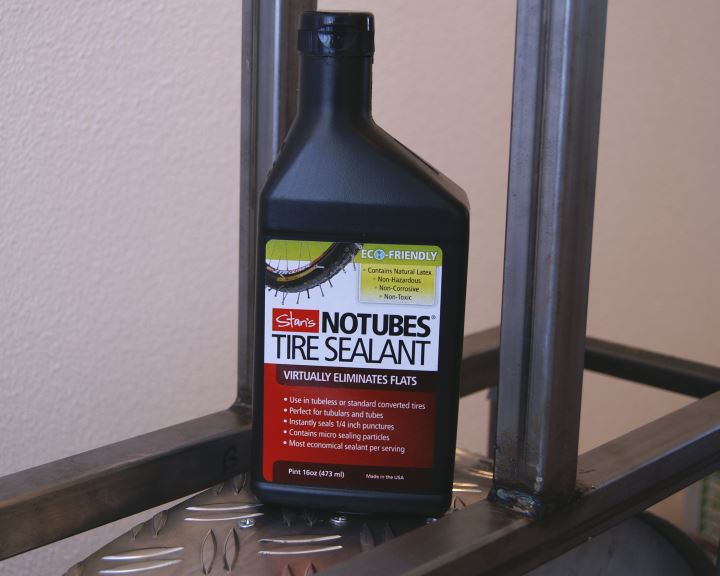Road Bike Special: The Effect of Tubeless Sealant on Rolling Resistance

How much does rolling resistance increase after adding sealant to a road bike tire? I think it's a given thing that nobody likes flats, but plenty of people do not want to give up a couple of watts for better puncture resistance. That's why I've been doing tests with sealant in a Schwalbe One Tubeless. Today I will share this information on Bicycle Rolling Resistance so everybody can decide for themselves if it's worth the trade-off.
Ad Buy Tubeless Sealant at Amazon.com
I have been doing more fun tests with a Schwalbe One Tubeless that are only possible with a tubeless tire, like testing the rolling resistance of an inner tube. For this article I have used the same Schwalbe One Tubeless I've used before, I've done tests with 0, 20 and 40 ml Stan's NoTubes Tubeless sealant and reran all tests.
Test Results
Adding sealant makes only a very small difference, noteworthy is that the rise in rolling resistance doesn't seem to be linear with the amount of sealant added to the tire. The first 20 ml only makes a very small difference, I suspect this is because a small amount of sealant sticks to the rim and bead where it doesn't add any rolling resistance.
| Schwalbe One Tubeless | 0 ml | 20 ml | 40 ml |
|---|---|---|---|
| Rolling Resistance 120 psi / 8.3 Bar | 11.8 Watts | 11.9 Watts | 12.4 Watts |
| Rolling Resistance 100 psi / 6.9 Bar | 12.5 Watts | 12.7 Watts | 13.2 Watts |
| Rolling Resistance 80 psi / 5.5 Bar | 13.8 Watts | 14.0 Watts | 14.4 Watts |
| Rolling Resistance 60 psi / 4.1 Bar | 16.3 Watts | 16.5 Watts | 17.1 Watts |
| Rolling Resistance Coefficient (Crr) 120 psi / 8.3 Bar | 0.00354 | 0.00357 | 0.00372 |
| Rolling Resistance Coefficient (Crr) 100 psi / 6.9 Bar | 0.00375 | 0.00381 | 0.00396 |
| Rolling Resistance Coefficient (Crr) 80 psi / 5.5 Bar | 0.00414 | 0.00420 | 0.00432 |
| Rolling Resistance Coefficient (Crr) 60 psi / 4.1 Bar | 0.00489 | 0.00495 | 0.00513 |
The optimal amount of tubeless sealant
After I removed the tire from the rim after testing, it contained 40 ml of tubeless sealant. There was quite a big puddle at the bottom of the tire, this should give very good puncture resistance. After removing 10 ml, there was still a decent puddle, removing another 10 ml resulted in not much of a puddle left. Based on these facts, I think the optimal amount to use should be 30 ml for a 25 mm road bike tire.
What about tubeless sealant in inner tubes?
These tests are run with a Schwalbe One Tubeless, which is a true tubeless tire that doesn't need sealant to hold air. Schwalbe does recommend adding some sealant to make this tire almost immune to punctures. You might think adding tubeless sealant to inner tubes to have the same effect but from experience I can tell you that it doesn't.
When conducting the puncture resistance tests, I use a standard butyl tube filled with Stan's NoTubes tubeless sealant. After puncturing the tire it does seal but it takes longer and after reinflating to high pressures, some holes start leaking again. The funny thing is that the outer tire does seal the hole and the air escapes through the rim and valve hole. Especially bigger holes in inner tubes don't seal as well when compared to a carcass of a tubeless tire which is much thicker. Tubeless sealant in inner tubes does work but not as well as in true tubeless tires, this is a big advantage for the tubeless tires.
Conclusion
The increase in rolling resistance of adding tubeless sealant to road bike tires is much smaller than I expected it to be. When using 30 ml of sealant in a 25 mm tire, total rolling resistance for a pair of tires increases by 1 Watt at a typical road bike speed of 23mph / 36 km/h. In my opinion, it definitely is worth it to run tubeless fluid in road bike tires.
Ad Buy Tubeless Sealant at Amazon.com
